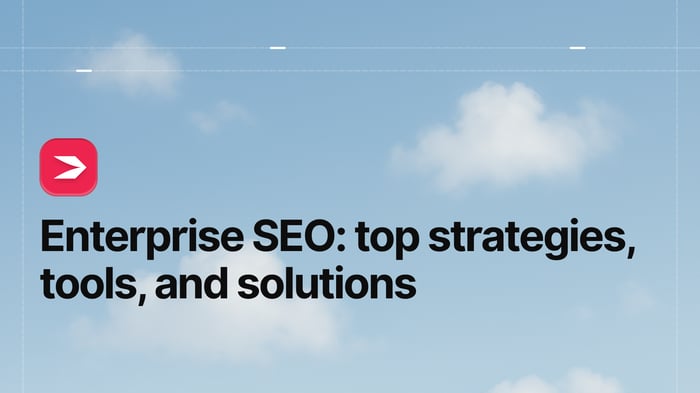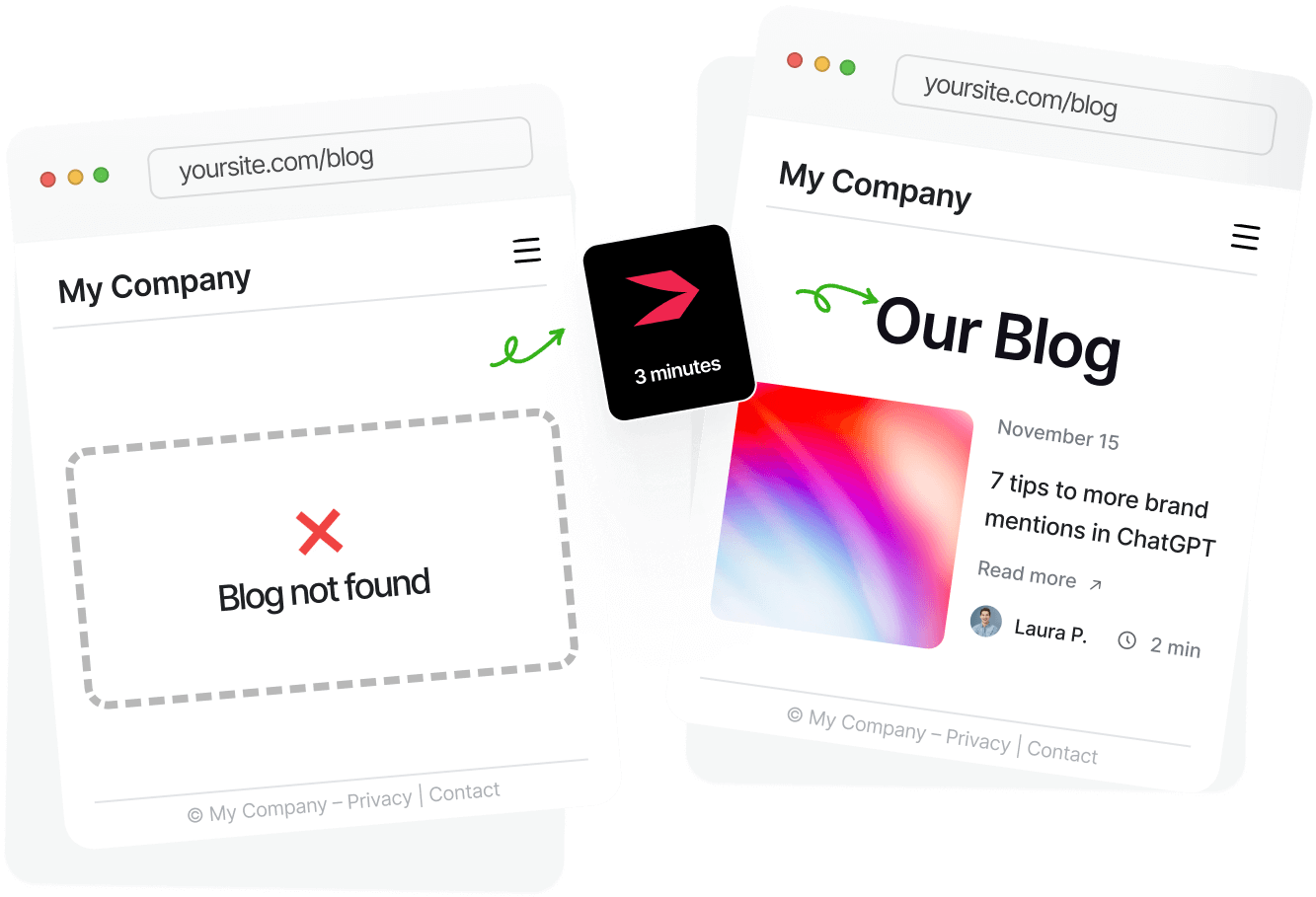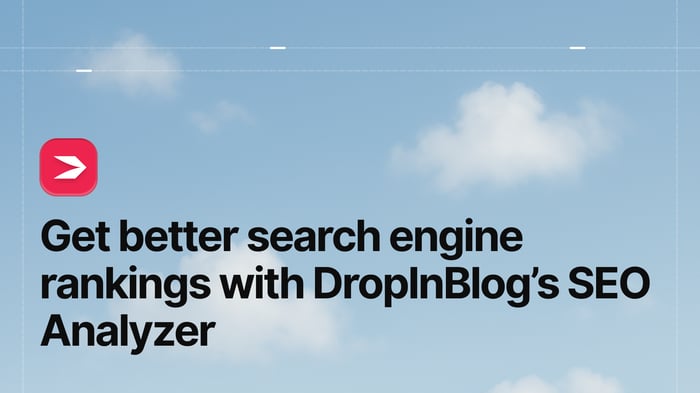The idea behind enterprise SEO is simple – to increase a website’s organic traffic and visibility in search results and drive more conversions and sales. The question is: how do you know which strategies will bring in the desired results? Or whether your site needs an enterprise SEO strategy at all? Well, you can’t know that. So, while there’s no bulletproof strategy that will work for all large businesses, this article will introduce you to the ones that have worked for enterprises like yours and help you decide whether you need these strategies in the first place.
Let’s start with a brief explanation of what enterprise SEO is.
Table of Contents
- Enterprise SEO Explained
- How Is Enterprise SEO Different From Traditional SEO?
- Do You Need Enterprise SEO?
- Enterprise SEO Strategies and Best Practices
- Technical Enterprise SEO Strategies
- On-Page Enterprise SEO Strategies
- Off-Page Enterprise SEO Strategies
- Create a Collaborative Environment
- Automation
- Enterprise SEO Tools and Solutions
- Closing Thoughts
Enterprise SEO Explained
Enterprise SEO is the process of optimizing search engine rankings and visibility for large websites. Its primary objective is to find techniques that will help enterprise-level websites manage content creation, link building, and technical SEO on a large scale.
As you might’ve guessed, securing visibility on search engines is quite a challenge. According to an Ahrefs study, 96.55% of all pages don’t get any visits from Google, with another 1.94% seeing between 1 and 10 monthly visits. So, how do you create a strategy that can help your site become part of the elite 1.51%? Not easily – you need a carefully planned enterprise SEO strategy, which is somewhat different from traditional SEO strategies.
How Is Enterprise SEO Different From Traditional SEO?
The primary difference between “traditional” and enterprise SEO is scalability. Just like you can’t stretch out a JPEG image and expect it to preserve the original quality, you can’t apply traditional SEO techniques to a large website with thousands of pages and expect them to work as they would for a small site with a hundred pages.

Let’s look at the number of indexed pages Arefs has – over 3.75 million! Can you imagine how long would it take for all content to be updated? Of course, not all pages need to be updated, but if they did it would take a team of 100 people, each updating about 100 pages a day, a full year to update this site. For tasks like these, you need a good strategy in place, as well as a powerful automation tool to help you manage sites with complex architecture.
Do You Need Enterprise SEO?
If you run a big company with many employees, you most likely need enterprise SEO. That’s not the only instance in which you need a large-scale approach to SEO, though. Companies with large websites – with pages numbering in the thousands or millions – also need an enterprise SEO strategy to help them rank well in search engine page results (SERPs).
After they find the strategy that works for them, large businesses can increase:
Organic website traffic
Brand awareness
Conversion rates and sales
Now that you have an overview of what and for whom enterprise SEO is, let’s look at some of the best enterprise SEO strategies and practices.
Enterprise SEO Strategies and Best Practices
As you’ll soon discover, SEO for large companies can be broken down into three large chunks – on-page, off-page, and technical SEO.
We’ll start with technical SEO, and you’ll see why.
Technical Enterprise SEO Strategies
The goal of each SEO type I just mentioned is to make your site visible on search engines. However, without technical SEO, your site might not be visible on search engines at all. Search engines need to find, index, and crawl your site pages to learn about your site’s content and make search suggestions based on what they learned about your site.
Before that can happen, your site needs to meet quite a few criteria. It should have fast loading times, be optimized for mobile devices, implement a proper site architecture (which translates to easy navigation), and a few other things.
So, let’s see which aspects of technical SEO are crucial for an enterprise SEO strategy.
Increase Site Speed
Site speed is one of the ranking factors, and if your website has slow loading times, that will reflect on your rankings.
To avoid having a slow website, you can implement a few useful practices such as compressing website images, minimizing redirects, and using a content delivery network (CDN).
Optimize Site Images
Images can take up a lot of space on your site, which is why you should reduce their size through image compression tools.
Speaking of image compression, you should also ensure that your site uses the right image format – a format that’s not too large but still preserves image quality. The choice is often between WebP and PNG files – the two image formats that support lossless compression, which means that you can reduce the image size and keep the image quality. If your biggest concern is speed and not so much the image quality, JPEG files can also be a good choice – when compressed, of course.
Use a CDN
A content delivery network is another great way to improve your site’s speed and performance. It uses a group of servers located in various locations in addition to caching (i.e., storing copies of) your site’s elements such as videos and HTML. When a user opens a webpage on your site, the CDN sends the user the cached version of that page from the server that’s closest to them. As a result, your site loads more quickly, which not only increases your site’s page speed but also creates a better user experience.
Minimize Redirects
Redirects are useful – when directing users from an HTTP connection to an HTTPS connection, or when migrating your website. However, having too many redirects impacts your site’s user-friendliness, whereas not using them the right way could negatively affect your SEO. Redirect chains and loops are another problematic area because they increase page loading times or leave a visitor in a loop, preventing them from accessing a page on your site.
To avoid these issues, try to limit your site’s use of redirects, and use an SEO audit tool like Ahrefs or Moz to manage all your redirects and fix any issues that might arise.
Use Clear Site Structure
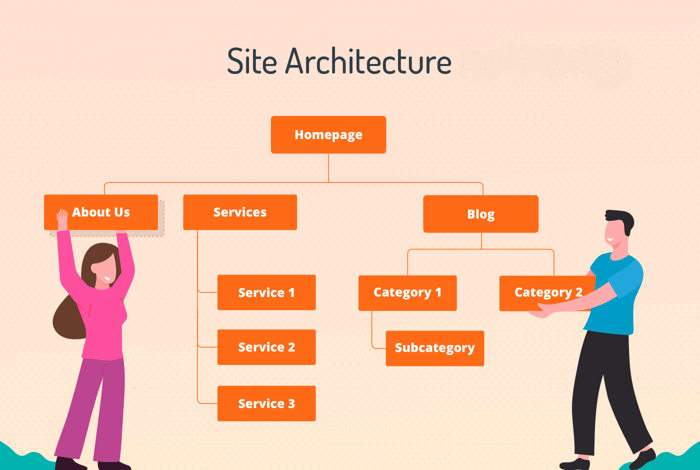
Another important aspect of a good enterprise SEO strategy is site structure. Simply put, the site structure is how your visitors (and search engine crawlers) navigate your site. The best practice is to use a hierarchical structure and organize your pages into the following categories: main pages, categories, and subcategories while ensuring users can get to any page on your site in 3 to 4 clicks.
Other good practices to follow include using the breadcrumbs menu and easy-to-read URLs and keeping your site’s structure design consistent.
XML Sitemaps
A site structure goes hand in hand with an XML sitemap because it provides an overview of all your site’s pages that you want to be indexed. It offers the same information as an HTML sitemap (which helps users find pages on your site) but for search engine crawlers. An XML sitemap is a way to tell search engines about the available pages on your site.
Did you know that a sitemap’s maximum size is 50MB, containing up to 50,000 URLs? So, if you have more than 50,000 pages on your site, you’ll need more than one sitemap.When it comes to XML sitemaps, you should pay attention to two things: index bloat and crawl budget.
The index bloat is an unpleasant “situation” where Google indexed a vast number of low-quality pages on your site. Old press releases and thank you pages are examples of pages you want to exclude from your XML sitemap. And because Google has finite resources it can dedicate to a single website in a single session, there is a thing called “crawl budget.” The problem arises when you spend your crawl budget on these low-quality pages – instead of the most important pages on your site.
To prevent index bloat, you need a robots.txt file which will instruct search engine crawlers which pages to index and which ones to skip. You can also use canonical URLs to prevent crawlers from indexing duplicate pages on your site, as well as remove internal links from low-quality pages.
When creating a sitemap, you can build one from scratch or use one of the enterprise SEO solutions that will automatically generate an XML sitemap for you. These solutions also have an automated way of finding any indexing issues on your site, which once identified, can be easily fixed.
Use Structured Data
Before we get to the on-page enterprise SEO strategies, there’s one more aspect of keeping your technical SEO in order, and that is the use of structured data and schema markup. This structured data helps search engines understand your site’s page content – videos, FAQs, articles, etc. Consequently, it makes indexing your site pages easier. And your site has a chance of appearing in Google’s rich results like the one below.

You can implement structured data into your pages with developers' help or by doing this task yourself. The latter is a less flexible option including third-party tools, but if you have the resources, you can assign this task to your IT department.
If you aren’t sure if your site uses structured data, you can test it using Google’s rich results test.
Now, let’s look at the on-page enterprise SEO strategies.
On-Page Enterprise SEO Strategies
Content is one of the pillars of an on-page SEO strategy – enterprise or not. As a large company, you’ll need a content development team to help you create valuable content for your audience. And the more content you create, the higher the chances of increasing your site’s organic traffic.
Create High-Quality Content at Scale
The content you create for your site should be first engaging and informative, but it should also address the different stages of the sales funnel – top, middle, and bottom. You should start with top-of-the-funnel (TOTF) content to create brand awareness and inform your leads about your brand, product, or service. As they move through the funnel, you’ll need the content to support your audience across all funnel stages. And for that, you’ll need an editorial team to help create and push the content into the publication stage.
Another thing to consider is cross-department collaboration. As you’re writing for both users and search engines, your content should implement the keywords you want to rank for (more on that later). To make that happen, you’ll need to ensure your editorial and SEO teams are on the same page, producing great content that has a chance of appearing in SERPs.
Update Your Content Regularly
Outdated content is one of the challenges large businesses face because they have thousands of pages they need to keep track of. One of the ways to overcome this obstacle is to group your site’s content into different categories such as evergreen and news, to help you prioritize the content that should be updated. You can then assign that content to your editorial team. Also, develop a plan for content updates and make it part of your content workflow.
Before you create a content plan, make sure you’ve selected a robust blogging platform that will make updating and creating new content easier. The platform you choose should be user-friendly, allow you to manage user permissions via user roles, and schedule your content – all of which you can achieve with an enterprise blogging solution like DropInBlog.
Create Linkable Assets
An often overlooked enterprise SEO strategy is to create content people are likely to link to. This is typically visual media (e.g., infographics and video tutorials), and well-researched evergreen content.
Internal Linking
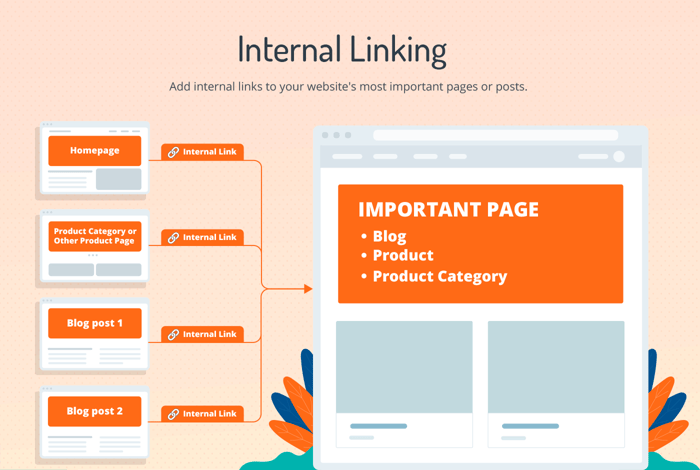
As mentioned above, site structure is important for helping search engines index your content. Without links leading from one page to another, a site structure is just a static outline of your website. You need to add links to your site’s most important pages, leading both search engines and users to different parts of your site.
When you add new content to your site, add links to and from other pages on your site so that it is seen by both search engines and your audience. If you don’t include a link in a piece of content, search engines are likely to miss it and not index it. From a user’s perspective, hitting a page that won’t take them to other content on your site will likely make them close your site altogether.
A word of advice – don’t link pages just for the sake of having internal links, but think of the value the linked page brings to your audience.
Keyword Research and Optimization
When looking for keywords to rank for, large companies often have strong competition. However, it’s also easier for them to rank for highly competitive keywords because they usually have high domain authority.
When doing your keyword research, it’s a good idea to go with a dedicated SEO tool to help you keep track of keyword rankings and changes. Some of the metrics that can help you find the right keywords to rank for include:
Search volume
Click-through rates (CTR)
Ranking difficulty
Search trends
Then, you can combine these metrics with the keywords your competitors rank for, which you can also get from these specialized SEO tools. The next step is to eliminate some of the keywords, such as the ones with low search volume or the ones that your competitors want to rank for but aren’t relevant to your site’s content. The keywords that are left are the ones you should focus on, and create and optimize the existing content for these keywords while having user intent in mind.
Once you’ve identified the right keywords for your website, follow best SEO practices, such as including keywords in your content, titles, and meta descriptions, to have your content reflect your SEO strategy.
Off-Page Enterprise SEO Strategies
The last part of an enterprise SEO strategy is off-site SEO, which involves different tactics to help you build brand authority – whether this is link building, writing guest posts, or managing public relations. For large businesses, link building has proven to be one of the most efficient enterprise SEO strategies.
Link Building Best Practices
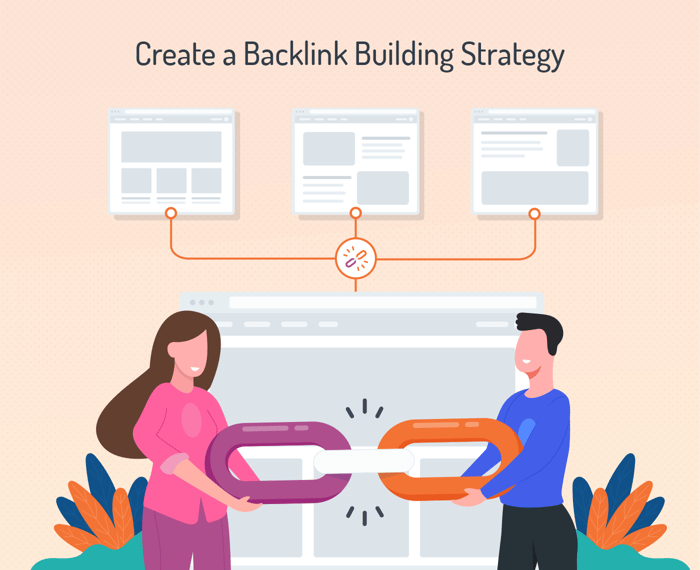
As you might already know, big companies get hundreds of backlinks without doing much of anything at all. They are industry leaders and have high domain authority, which is reason enough for smaller companies to link to these large websites.
And while a part of link building happens naturally, you can also incorporate some linking practices to boost your authority. An example of these practices is to look for unlinked brand mentions. These are when your company’s name has been mentioned somewhere without linking to your website. What you can do in these situations is to reach out to the websites that mention your brand and ask them to add a link to your site.
If you dedicate sufficient resources to your content marketing strategy and your content development team produces high-quality content, you’re likely to gain backlinks to your content – not just because you have high domain authority, but because people love good content.
Create a Collaborative Environment
Enterprises usually have several departments – each focused on their specialty: content creators, SEO specialists, sales teams, executives, and legal departments. The challenge with implementing enterprise SEO strategies is to get all these departments on board with an idea.
To turn ideas into action, present the strategy you want to implement by highlighting its benefits for each department. Create a clear plan of who will be responsible for what, while ensuring not only are responsibilities tangible but results as well.
Automation
With an enterprise-level website, your goal is to put as many tasks as you can on autopilot. For this, you can use a project management tool to help with content production. And an all-in-one SEO solution can help you schedule site audits, generate reports based on the metrics you set, as well as monitor your content and keyword rankings. Managing a website with thousands of pages is a time-consuming project, so using these tools can take some work off of your plate.
Enterprise SEO Tools and Solutions
Apart from finding the best enterprise SEO strategies that can bring desirable results to your company, you need help with executing these strategies. In many cases, relying on enterprise SEO tools and solutions can help with complex tasks that require a lot of resources or can be automated, such as site audits.
The enterprise SEO market offers various tools, but before you select one, make sure it offers most of the following features:
Keyword research and analysis: The solution you choose should help you find and track the rankings of the keywords you want to rank for.
Competitor analysis: You should also have in-depth insights into your competitors’ rankings, the keywords they are targeting, and more.
Technical SEO audits: You should be able to view technical issues on your site, such as crawl errors or broken links so that you can quickly find and fix those errors.
Backlink management: Most enterprise SEO tools will help you find new backlink opportunities.
Integration with data sources: The platform of your choice should also integrate with data sources like Google Analytics.
Visualization tools: Due to the large amount of data these solutions offer, enterprise SEO tools should offer a simple way of processing the provided data through charts and graphs.
User account: As your company probably has a team of SEO experts, you need a solution that supports multiple user accounts.
Other features worth exploring are:
Ease of use
The option to test the solution before buying it
User reviews
Customer support and how responsive they are
Some of the most prominent players in the enterprise SEO field are Ahrefs, Moz, Conductor, and seoClarity. To see how these solutions can help you run your website more efficiently, sign up for a free trial to get first-hand experience with their features and capabilities.
Closing Thoughts
Finding the enterprise SEO strategies that will work for your site and the tools to help you streamline your SEO tasks isn’t simple. This article, meanwhile, was created to help you get started, and eventually, implement the strategies and solutions that meet the specific requirements of your business. That process might take a while, but it’s well worth it because, in the end, it’ll lead you to the best strategy for your business.
About DropInBlog: DropInBlog is a cloud-based blogging platform that you can easily integrate with your existing website. If you still haven’t found an enterprise blogging platform that meets your requirements or you’re thinking about switching from the one you’re currently using, feel free to explore DropInBlog’s features. Or if you want to see how it all works up close, sign up for our free trial.
